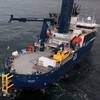The world LPG carrier fleet is forecast to expand from 14.5 million cu. m. at the
beginning of 2005 to 24.6 million cu. m. by 2015. World seaborne LPG trade (including ammonia and petchems) is forecast to increase from 73 mt to 132 mt over the same period.
These are some of the findings in the new detailed report – entitled ‘LPG Carriers: Market Prospects to 2015’ – which analyses the current and historical developments within the LPG carrier sector and examines the prospects for trade and fleet development under alternative scenarios, presenting detailed forecasts for trade volumes, fleet requirements and freight rates through to 2015.
The following highlights some of the findings of the Report:-
World LPG Fleet Development to 2005
• The world LPG fleet was estimated at 14.5m cu. m. at the beginning of 2005, made up of 990 vessels dominated by the VLGC sector which accounts for 57% of fleet capacity.
• By mid 2005, the LPG carrier orderbook totaled approximately 3.6m cu. m.
(88) vessels, equivalent to 24% of the current fleet capacity.
• South Korean yards dominate the LPG carrier newbuilding market with 76%
of the orderbook. Japanese yards account for 17% of the newbuilding fleet
capacity.
World LPG Production & Consumption
• Total seaborne LPG trade was approximately 48m tons during 2004.
• The transportation of ammonia accounts for approximately 1 in 5 cargoes
carried by gas carriers and is particularly important to the LGC and MGC
sectors and accounted for approximately 15m tonnes of seaborne trade in
2004.
• The four main petrochemicals are: Ethylene; Propylene; Butadiene; and VCM. These accounted for approximately 10m tons of seaborne trade in 2004.
LPG Carrier Freight Rates & Costs – Recent Developments
• Average 1-Year Time Charter Rates for VLGCs climbed from $0.58m/month
in 2003 to $1.1m/month by the end of 2004. The start of 2005 was quiet, but
demand stayed strong and vessel availability continued to be restricted.
• Newbuilding prices strengthened significantly during 2004, and continued to
rise during 2005, with VLGC prices averaging over $82m during 2004, with
reports of some vessels reaching $90m during the start of 2005.
• Secondhand prices based on 10-year old vessels show that VLGC prices
have increased from the lows of 2002 at $39.2m to $48.0m currently. The
smaller vessels have increased more in value over recent years.
Source: OSC
• Aggregate annual LPG carrier Operating Costs approximate US$2.0-2.9m
across the classes, linked to vessel size.
LPG Production & Consumption to 2015
• Seaborne LPG trade is forecast to increase from 48m tons in 2004 to 68m
tons by 2010 and to 96m tons by the end of the study period.
• Seaborne ammonia trade is forecast to grow from approximately 15m tons
in 2004 to 18.2m tons in 2010 and increase to 21m tons by 2015.
• Seaborne petrochemical trade is forecast to rise from 10m tons in 2004 to
13.2m tons by 2010 and to 15.5m tons by 2015.
LPG Fleet Development to 2015
The LPG fleet is forecast to grow from 14.5m cu. m. to 18.6m cu. m. by 2010 and
expand to 24.6m cu. m. by 2015. The VLGC sector is set to witness the largest
growth, with capacity rising by 82%, from 8.3m cu. m. to over 15.0m cu. m.
LPG Carrier Freight Rates & Costs to 2015
• 1-year time charter rates for VLGCs are forecast to fall in the near-term, but
recover by 2009. There is likely to be a market ‘correction’ around 2010,
followed by a fall in rates with a subsequent recovery, with freight rates
reaching US$1.0m/month by 2015.
Source: OSC
For more information on the report, contact: Ocean Shipping Consultants Ltd,
Telephone : +44 (0)1932 560 332; E-mail : [email protected]
Sponsored Content
Chris-Marine’s solutions help to prolong engine lifetime

March 2024
 Read the Magazine
Read the Magazine

 Read the Magazine
Read the Magazine
This issue sponsored by:

America’s Watershed Initiative: Sustaining a Critical Waterway
Subscribe for
Maritime Reporter E-News
Maritime Reporter E-News is the maritime industry's largest circulation and most authoritative ENews Service, delivered to your Email five times per week










